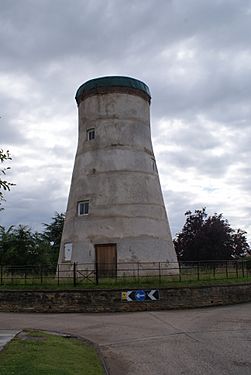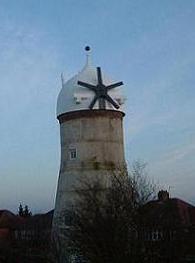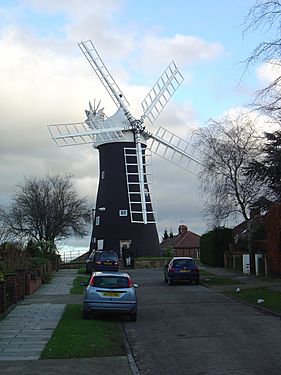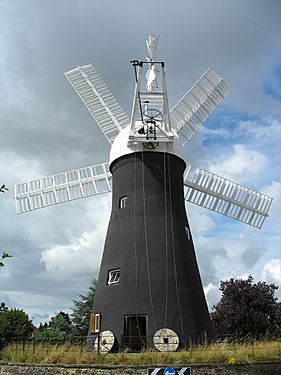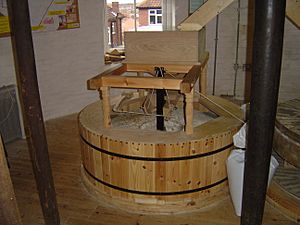Holgate Windmill facts for kids
Quick facts for kids Holgate Mill, York |
|
|---|---|
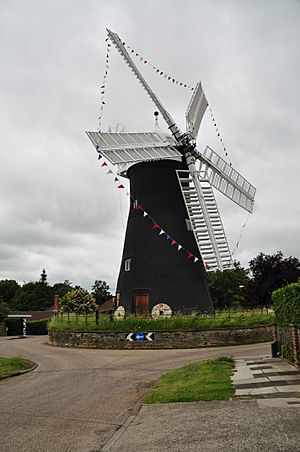
The mill in June 2014
|
|
| Origin | |
| Mill name | Holgate Mill |
| Grid reference | SE 5841 5148 |
| Coordinates | 53°57′22″N 1°06′41″W / 53.9561°N 1.1113°W |
| Operator(s) | Holgate Windmill Preservation Society |
| Year built | 1770 |
| Information | |
| Purpose | Corn mill |
| Type | Tower mill |
| Storeys | Five storeys |
| No. of sails | Five sails |
| Type of sails | Double Patent sails |
| Windshaft | Cast iron |
| Winding | Fantail |
| Fantail blades | Eight blades |
| Auxiliary power | Electric Motor (1930) |
| No. of pairs of millstones | Four Pairs |
| Other information | Restored and working |
Holgate Windmill is a tall, working windmill located in Holgate, a part of York, England. It has been carefully repaired and can now grind grain again. This type of windmill is called a tower mill because of its tall, round shape.
Contents
The History of Holgate Windmill
Building the Mill
Holgate Windmill was built in 1770. It was made of brick. The first owner and miller was George Waud. He, his son, and his grandson ran the mill until 1851. A house was also built near the mill around the same time.
The mill first had five special sails called Roller Reefing sails. These were later changed to Double Patent sails. By 1841, the mill had three pairs of millstones from France. It also had machines to clean the flour. By 1858, a fourth pair of millstones was added.
Changes and Upgrades
In 1859, a new building for storing grain was added. A steam engine was also put in. This helped the mill make more money. An extra floor was built, making the mill as tall as it is today.
In 1930, a big electric motor was installed. This replaced the old steam engine. The chimney and boiler house were taken down. After a storm damaged the sails, the mill stopped grinding grain using wind power. The city council then removed the sails and the fantail. The mill stopped grinding completely in 1933. In 1939, a new white cap was built on top of the mill tower.
The last known miller was Thomas Mollet. The Gutch family were the last known owners of the mill.
Becoming a Protected Building
In 1954, the mill was given Grade II listed status. This means it is an important historic building. More repairs were made to the cap in 1955. Its five long wooden parts that hold the sails were removed in 1956.
Bringing the Mill Back to Life
In 2001, a group called the Holgate Windmill Preservation Society was started. Their goal was to save the mill. In 2005, the mill opened its doors to the public for the first time in 70 years.
Planning to fix the mill began in 2003. The actual repair work started in 2006. Scaffolding was put up around the mill. Workers removed the old black paint and plaster from the outside. New electricity was installed. New oak doors and windows were built. A new type of plaster, called lime render, was put on the outer walls.
In autumn 2006, the old cap, along with its parts, was lifted off by a crane. The old ring that held the cap was broken. Its wooden frame was rotten. In 2007, most of the outside repairs were finished. A new ring was lifted into place. The scaffolding was removed. The open top of the mill was sealed to keep out rain.
On November 28, 2009, a new white cap was lifted onto the mill. It included a ball on top, a brake wheel, a windshaft, and a five-part iron cross. Five new sails were put on the mill on December 20, 2011. The next year, shutters were added to the sails. In April 2012, the sails turned by wind power for the first time since 1930. The mill officially reopened on June 23, 2012.
Today, the mill usually works one day a week. It makes about 75 kilograms (165 pounds) of wholemeal and spelt flour. During the Covid-19 outbreak, more people wanted flour. So, the mill increased its production to 400 kilograms (880 pounds) per week.
How Holgate Mill Works
Inside the Mill
Holgate Mill has five floors, including the ground floor. These floors are:
- The meal floor, where the flour is collected.
- The stones floor, where the millstones are.
- The bin floor, where grain is stored before grinding.
- The dust floor, which helps keep dust out of the machinery.
- The cap, which is the top part of the mill.
The mill originally had a black, curved cap. Since 1939, it has had a white cap. This cap was turned by a fantail to face the wind. Five Double Patent sails were attached to a cast-iron windshaft. They were mounted on a cross, like windmills in Lincolnshire. The mill used four pairs of millstones to grind grain. Three pairs were French Burrs, and one pair was made of Peaks stone.
Millers of Holgate Windmill
Here is a list of the people who ran Holgate Windmill:
- George Waud (1770–1792)
- George Waud Jr (1792–1811)
- George Waud (grandson) (1811–1851)
- John Thackwray (1851–1855)
- George & Joseph Chapman (brothers) (1858–1860)
- William Bean Horseman (1860–1866)
- Joseph Chapman (1866–1896)
- Charles Chapman (son of Joseph) (1896–1902)
- Herbert Warters (1902–1922)
- Thomas Mollett (1922–1933)
See also


